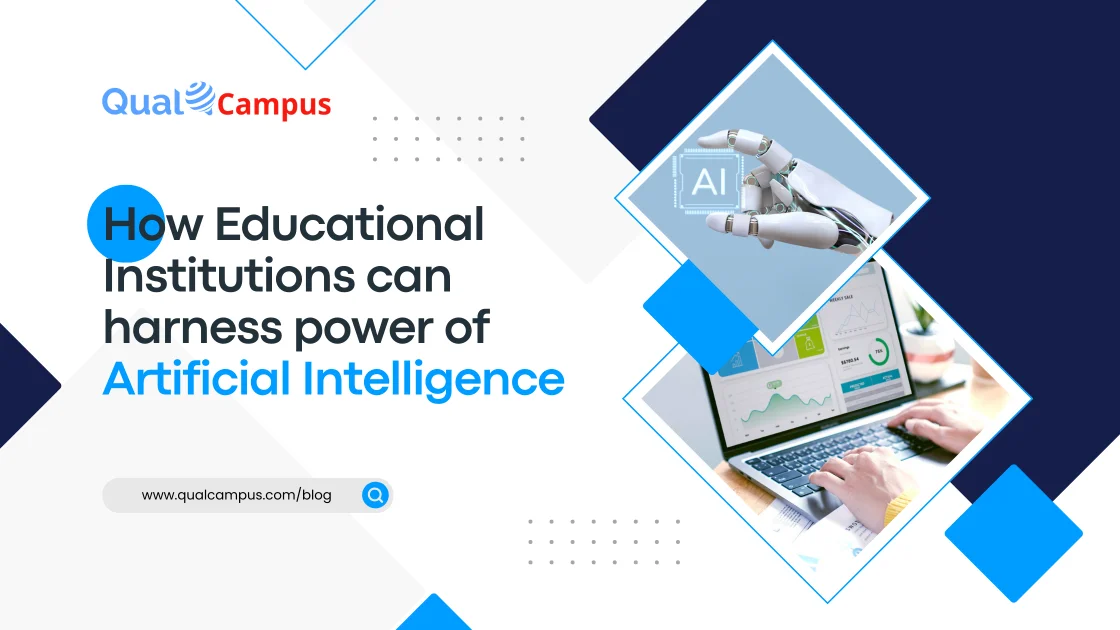To stay ahead in the fast changing education landscape, adopting AI technologies is crucial. Below are the Artificial Intelligence Technologies which can be used by Education Organisations.
Table of Content
1. Machine Learning (ML) – Predictive analytics for student performance & financial planning.
ML can analyze historical data to predict student outcomes, identify at-risk students, marks given by faculties, faculty and other Staff work load and optimize financial planning and resource allocation.
A. Student Performance Prediction
ML models can analyze data such as:
- Attendance records
- Assignment submissions
- Exam scores
- LMS interaction patterns
- Behavioral data (library usage, extracurricular participation)
Benefits:
- Early Warning System: Identify students likely to fail or drop out and trigger interventions.
- Personalized Learning: Recommend tailored study plans and content based on individual learning patterns.
- Improved Outcomes: Faculty can proactively support at-risk students.
Example: A student with consistent low attendance and delayed assignment submissions gets flagged. The system notifies the academic advisor and sends the student customized study content.
B. Faculty & Staff Workload Optimization
ML can assess:
- Teaching hours
- Evaluation workload
- Research activities
- Non-academic duties (admin tasks, student mentoring)
Benefits:
- Balanced Workload Distribution: Ensure fair assignment of classes and administrative duties.
- Faculty Burnout Prevention: Detect overburdened staff and suggest redistribution.
- Departmental Efficiency: Optimize staff allocation across departments and semesters.
Example: If a faculty member is managing 4 theory courses plus administrative duties, the system can flag overload and recommend reallocation.
C. Financial Planning & Resource Allocation
ML models analyze:
- Fee payment trends
- Department-wise spending
- Resource utilization (labs, classrooms, library)
- Historical budgeting patterns
Benefits:
- Fee Defaulter Prediction: Identify students at risk of delayed payments and automate reminders.
- Budget Forecasting: Predict funding needs per department based on historical trends.
- Resource Optimization: Recommend underutilized lab/classroom assets for reallocation.
Example: The system predicts lower lab utilization in the upcoming semester and reallocates budgets to departments with higher demand.
2. Natural Language Processing (NLP) – AI-driven chatbots & automated documentation.
NLP can power chatbots to answer student queries, provide support, and automate the creation and management of documents, such as reports and transcripts.
A. AI-Powered Chatbots for Student Support
NLP-based chatbots can serve as 24/7 virtual assistants across various domains:
Admissions & Enrollment Support:
- Answer FAQs on eligibility, deadlines, documents, courses, and fees
- Guide students through online application and form filling
- Provide personalized status updates on application progress
Academic Assistance
- Help students find lecture schedules, assignment due dates, or grade reports
- Suggest elective courses based on interests or performance
- Route complex queries to the right faculty or staff member
Administrative & Campus Life Queries
- Provide real-time info on campus events, transportation, or library hours
- Handle hostel-related or exam hall ticket inquiries
- Support grievance management and student feedback
Benefits:
- Reduces burden on administrative staff
- Delivers instant, accurate, and consistent responses
- Available 24/7, even outside office hours
Example: A student types “How can I apply for a scholarship?” into the chatbot. The NLP system understands intent and responds with relevant eligibility details, deadlines, and links to apply.
B. Automated Documentation with NLP
NLP can analyze, generate, and manage academic and administrative documents with minimal manual input:
Auto-Generated Reports & Letters
- Student performance reports
- Internship & recommendation letters
- Attendance summaries
- Fee receipts and reminders
Transcript & Certificate Generation
- Extract data from student records and auto-fill formats
- Handle formatting, digital signatures, and secure PDF generation
- Multilingual support using AI translation if needed
Form Recognition & Processing
- NLP can scan handwritten or typed forms (using OCR + NLP)
- Extract key fields (name, ID, grades, etc.) and populate ERP modules automatically
Benefits:
- Saves time for faculty/admins
- Reduces errors in data entry
- Ensures document consistency and regulatory compliance
Example: When a student requests a transcript, the system automatically compiles academic history, formats the document, adds watermarks/digital seals, and sends it via email or portal download.
3. Computer Vision – Facial recognition for attendance & security.
Computer vision can be used for automated staff and students attendance tracking through facial recognition and enhance campus security by monitoring and identifying individuals.
A. Facial Recognition for Automated Attendance
How It Works:
- High-resolution cameras (or mobile devices) capture facial images at entry points or in classrooms.
- Computer Vision models identify and match faces with stored student/faculty data.
- Attendance is auto-marked in the ERP system in real-time.
Key Features:
- Works even in large classes or examination halls
- Supports mask detection or temperature checks (via thermal imaging)
- Handles group and individual recognition
- Syncs with class schedules and room allocation data in ERP
Benefits:
- Eliminates proxy attendance
- Saves time compared to manual or biometric systems
- Enables real-time dashboards for faculty and admin
- Integrates with parent portal to notify absenteeism
Example: Students walking into a classroom are instantly identified. Attendance is updated in the ERP, and a report is generated for the instructor.
Campus Security & Access Control
Applications:
- Monitor entry/exit gates and restricted areas
- Verify staff, student, and visitor identity
- Detect unknown individuals or suspicious activity
- Alert security teams via ERP-integrated dashboard
Use Cases:
- Access Control: Only authorized staff/students can enter labs, hostels, or exam rooms.
- Intrusion Detection: Alerts when unknown individuals enter restricted areas.
- Event Surveillance: Crowd monitoring during events or emergencies.
- Vehicle Recognition: CV systems can also read license plates for parking access control.
Benefits:
- Increases campus safety
- Enables audit trails (who entered where & when)
- Reduces dependence on physical ID cards
- Enhances compliance with safety protocols
Example: A visitor enters the admin building; the camera scans their face and alerts the front desk via ERP-integrated notification if the face is not registered.
4. Robotic Process Automation (RPA) – Streamlining administrative workflows.
RPA can streamline repetitive administrative tasks such as enrollment, scheduling, and data entry, mailing, freeing up staff to focus on more strategic activities.
A. Student Enrollment & Admission
- Auto-verification of application forms (e.g., checking uploaded documents for format/completeness)
- Email/SMS alerts for missing documents or next steps
- Data extraction and entry into student information system (SIS) or ERP
Example: As soon as a student submits an application, an RPA bot checks for missing fields, updates the ERP, and triggers a confirmation email.
B. Timetable & Exam Scheduling
- Pulls data on faculty availability, classroom capacity, and course requirements
- Creates and updates timetables or exam schedules in ERP
- Automatically resolves conflicts (e.g., double-booked rooms or overlapping exams)
Example: A change in a faculty member’s availability automatically triggers the bot to reassign classes and notify affected students via the portal.
C. Document Processing & Data Entry
- Reads and extracts information from documents (using OCR + RPA)
- Inputs data into the appropriate fields in the ERP (e.g., marks, ID proofs, medical certificates)
- Generates reports, admission letters, grade sheets, etc.
Example: After exam results are scanned, the bot reads each paper’s marks and updates the ERP student records instantly.
D. Communication & Notifications
- Auto-sends emails/SMS about fee due dates, exam reminders, or schedule changes
- Customizes messages based on student data (e.g., course, year, attendance)
Example: Students with <75% attendance automatically get personalized warnings and meeting requests with academic advisors.
E. Fee Collection & Financial Reconciliation
- Sends reminders for upcoming or overdue payments
- Verifies fee transactions from the bank/payment gateway with ERP records
- Flags mismatches and generates finance reports
Example: A student pays via UPI; the RPA bot updates their fee ledger and sends a receipt without manual intervention.
Conclusion:
These technologies can significantly enhance efficiency, personalization, and security in educational organizations. However proper implementation and training is very important to maximize their benefits.
Are you leveraging AI in your institution? Let’s discuss!
Where can you find the Best ERP with CRM, LMS & SIS in the Market?
When it comes to finding ERP with CRM, SIS & LMS, you have several options available. While many CRM providers offer them, QualSoft stands out as one of the leading brands renowned for providing exceptional CRM, LMS & ERP solutions. Our comprehensive range of offerings includes features such as Customer Relationship Management with ChatBot, Fees Management, Admission Management, Exam Management, Learning Management, Student Training & Placement Management, Online Class Management System, and a Cloud Based Student Information Systems (SIS) top-notch.
If you’re considering implementing or upgrading your existing CRM system in your educational institution, whether it’s a University, College, School, or group of institutions, look no further than QualCampus. With our cutting-edge CRM, ERP & LMS solutions, you can streamline your administrative processes, enhance collaboration, and provide a seamless learning experience for your students. QualCampus is your ultimate one-stop solution for all your CRM, ERP & LMS needs in the education sector.







